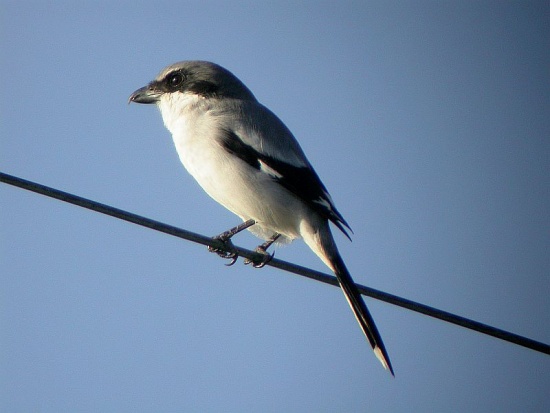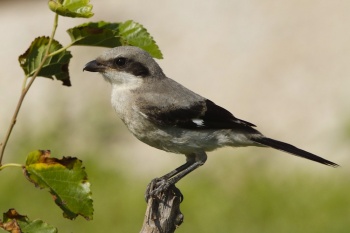(Flight picture added. References updated) |
|||
| (6 intermediate revisions by 5 users not shown) | |||
| Line 1: | Line 1: | ||
| − | + | [[Image:Loggerhead_Shrike.jpg|thumb|550px|right|Photo by {{user|rb+stern|rb stern}} <br /> Sanibel Island Causeway, [[Florida]], [[USA]], November 2003]] | |
| − | [[Image:Loggerhead_Shrike.jpg|thumb|550px|right|Photo by rb stern]] | + | ;[[:Category:Lanius|Lanius]] ludovicianus |
| + | |||
==Identification== | ==Identification== | ||
| + | Length 9 inches (18-22 cm), weight 43-54 g<br /> | ||
| + | Gray head and back, white under parts, broad black face mask extending narrowly across above the bill, black bill. Wings and tail black with white flash at base of primaries; scapulars gray with white tips (white varying in width between different subspecies). Juvenile finely barred. | ||
| + | ====Similar species==== | ||
| + | [[Image:Loggerhead Shrike juvenile .jpg|thumb|350px|right|Juvenile<br />Photo by {{user|Stanley+Jones|Stanley Jones}}<br />Galveston Island State Park, [[Texas]], [[USA]], June 2015]] | ||
| + | [[Northern Shrike]] differs in being slightly larger and longer-tailed, and with the black mask never extending onto the forehead. | ||
| − | + | ==Distribution== | |
| − | + | [[Image:Loggerhead Shrike Bryan1.jpg|thumb|350px|right|Photo © by {{user|Stanley+Jones|Stanley Jones}}<br />Country Club Lake, Old Travis B. Bryan Municipal Golf Course, Bryan, Brazos County, [[Texas]], [[USA]], December 2019]] | |
| − | + | [[North America]] (north to south-central [[Canada]]) and [[Mexico]]. Populations in south, west, and east [[USA]] resident, those in north-central USA and Canada migrate a short way south in winter. Canadian and eastern populations declining; no longer breeding in the northeast US, where now a scarce passage visitor. | |
| − | |||
| + | ==Taxonomy== | ||
| + | ====Subspecies==== | ||
| + | Eleven subspecies are recognized<sup>[[#References|[1]]]</sup>: | ||
| + | *''L. l. gambeli'': Western [[North America]] (south-western [[Canada]] to south-western [[US]]); winters to western [[Mexico]] | ||
| + | *''L. l. excubitorides'': Great Plains region of North America; winters to southern Mexico | ||
| + | *''L. l. migrans'': Eastern North America (south-eastern Canada to eastern [[Texas]]); winters to north-eastern Mexico | ||
| + | *''L. l. sonoriensis'': Arid south-western US to north-western Mexico (northern Durango and southern Sinaloa) | ||
| + | *''L. l. anthonyi'': Northern Channel Islands (off southern [[California]]) | ||
| + | *''L. l. mearnsi'': San Clemente Island (off southern California). ±13 birds in wild 1999 | ||
| + | *''L. l. grinnelli'': Southern California (San Diego County) and northern [[Baja California]] | ||
| + | *''L. l. nelsoni'': Southern Baja California | ||
| + | *''L. l. ludovicianus'': Coastal south-eastern US ([[Virginia]] to [[Florida]]) | ||
| + | *''L. l. miamensis'': Southern Florida | ||
| + | *''L. l. mexicanus'': Central Mexico (southern Tamaulipas and Nayarit to Oaxaca) | ||
| + | The subspecies differ mainly in the tone of gray; generally darker in the south of the range and paler in the north, but southern [[Florida]] birds also pale. | ||
| − | |||
| − | |||
| − | |||
| − | |||
==Habitat== | ==Habitat== | ||
| − | + | Semi-open areas with scattered shrubs and rough grass; also uses fence lines and utility poles in low-intensity agricultural land. | |
==Behaviour== | ==Behaviour== | ||
| + | ====Breeding==== | ||
They nest in a dense tree or shrub. The female lays 4 to 8 eggs in a bulky cup built from twigs and grass. | They nest in a dense tree or shrub. The female lays 4 to 8 eggs in a bulky cup built from twigs and grass. | ||
| − | + | ====Diet==== | |
| − | + | Diet includes large insects, also rodents and small birds. | |
| − | + | ==References== | |
| − | + | #{{Ref-Clements6thAug19}} | |
| − | + | {{ref}} | |
| − | |||
| − | |||
| − | |||
| − | |||
| − | |||
==External Links== | ==External Links== | ||
{{GSearch|Lanius+ludovicianus}} | {{GSearch|Lanius+ludovicianus}} | ||
| − | [[Category:Birds]] | + | [[Category:Birds]] [[Category:Lanius]] |
Revision as of 22:09, 26 December 2019
- Lanius ludovicianus
Identification
Length 9 inches (18-22 cm), weight 43-54 g
Gray head and back, white under parts, broad black face mask extending narrowly across above the bill, black bill. Wings and tail black with white flash at base of primaries; scapulars gray with white tips (white varying in width between different subspecies). Juvenile finely barred.
Similar species
Northern Shrike differs in being slightly larger and longer-tailed, and with the black mask never extending onto the forehead.
Distribution

Country Club Lake, Old Travis B. Bryan Municipal Golf Course, Bryan, Brazos County, Texas, USA, December 2019
North America (north to south-central Canada) and Mexico. Populations in south, west, and east USA resident, those in north-central USA and Canada migrate a short way south in winter. Canadian and eastern populations declining; no longer breeding in the northeast US, where now a scarce passage visitor.
Taxonomy
Subspecies
Eleven subspecies are recognized[1]:
- L. l. gambeli: Western North America (south-western Canada to south-western US); winters to western Mexico
- L. l. excubitorides: Great Plains region of North America; winters to southern Mexico
- L. l. migrans: Eastern North America (south-eastern Canada to eastern Texas); winters to north-eastern Mexico
- L. l. sonoriensis: Arid south-western US to north-western Mexico (northern Durango and southern Sinaloa)
- L. l. anthonyi: Northern Channel Islands (off southern California)
- L. l. mearnsi: San Clemente Island (off southern California). ±13 birds in wild 1999
- L. l. grinnelli: Southern California (San Diego County) and northern Baja California
- L. l. nelsoni: Southern Baja California
- L. l. ludovicianus: Coastal south-eastern US (Virginia to Florida)
- L. l. miamensis: Southern Florida
- L. l. mexicanus: Central Mexico (southern Tamaulipas and Nayarit to Oaxaca)
The subspecies differ mainly in the tone of gray; generally darker in the south of the range and paler in the north, but southern Florida birds also pale.
Habitat
Semi-open areas with scattered shrubs and rough grass; also uses fence lines and utility poles in low-intensity agricultural land.
Behaviour
Breeding
They nest in a dense tree or shrub. The female lays 4 to 8 eggs in a bulky cup built from twigs and grass.
Diet
Diet includes large insects, also rodents and small birds.
References
- Clements, J. F., T. S. Schulenberg, M. J. Iliff, S. M. Billerman, T. A. Fredericks, B. L. Sullivan, and C. L. Wood. 2019. The eBird/Clements Checklist of Birds of the World: v2019. Downloaded from http://www.birds.cornell.edu/clementschecklist/download/
Recommended Citation
- BirdForum Opus contributors. (2024) Loggerhead Shrike. In: BirdForum, the forum for wild birds and birding. Retrieved 24 April 2024 from https://www.birdforum.net/opus/Loggerhead_Shrike





